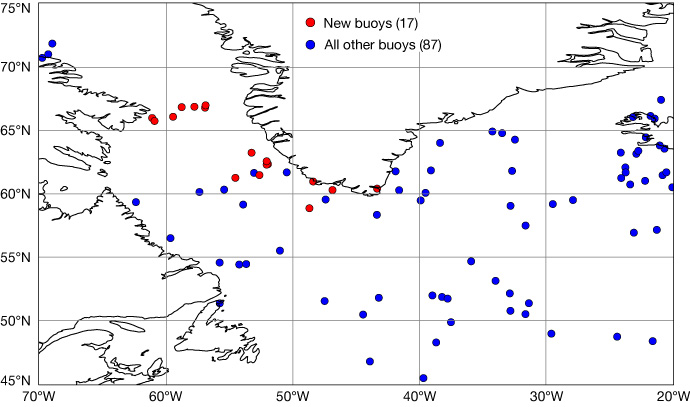In August and September 2021, 18 drifting buoys were deployed off southern Greenland and in the Davis Strait. An important feature of these buoys for ECMWF is that they provide valuable sea-level pressure observations in this region. Measurements of sea-level pressure are crucial for numerical weather prediction as (i) it is an important variable linked to the main mode of extratropical synoptic variability; (ii) many ocean areas have few other in‑situ observations; and (iii) satellite data still only provide a small amount of information about pressure at mean sea level. The buoys can operate for up to two years and are a costeffective component of the global observing system.
How the deployment came about
This deployment was made possible by a project entitled Targeted Experiment to Reconcile Increased Freshwater with Increased Convection (TERIFIC), which is funded under the European Union’s Horizon 2020 research and innovation programme (grant agreement No. 803140). Within TERIFIC, drifting buoys are being deployed to understand the pathways by which the meltwaters from Greenland and the Arctic make their way to the open ocean, and in turn affect the large-scale ocean circulation. In this region – the Labrador Sea – ocean stratification is relatively weak, which means that wintertime storms and heat loss from the ocean to the atmosphere enables surface waters to mix down to depths of one kilometre or more in a process known as deep ocean convection. TERIFIC has set out to monitor this exchange and diagnose the processes controlling the rate and efficiency of freshwater export.
The drifting buoys to be launched in TERIFIC initially had no pressure sensors on board. However, a collaboration between ECMWF, the EUMETNET Surface Marine Programme (E-SURFMAR), the Lagrangian Drifter Laboratory and the Center for Western Weather and Water Extremes (CW3E) (the last two at Scripps Institution of Oceanography) enabled 17 of the 18 buoys to provide pressure observations. The Surface Velocity Program Barometer drifters (SVPB; https://gdp.ucsd.edu/ldl/svpb/) they use were funded by E-SURFMAR, the Global Drifter Program funded by the US National Oceanic and Atmospheric Administration (https://gdp.ucsd.edu/ldl/global-drifter-program/), the California Department of Water Resources, and the U.S. Army Corps of Engineers.

Potential for better forecasts
Two ships were used to release the buoys, a Woods Hole Oceanographic Institution ship off southern Greenland in August, and the USCGC Healy in the Davis Strait in September. The sea-level pressure observations from these extra buoys have been assimilated into the ECMWF Integrated Forecasting System since shortly after their release, providing forecast benefits across the northwest North Atlantic Ocean and the potential to improve forecast skill over Europe in the medium range. This deployment is also timely with the forthcoming winter season and storm activity.
Further information on pressure observations from drifting buoys is available in Ingleby and Isaksen (2018; doi.org/10.1002/asl.822), Centurioni et al. (2017; doi.org/10.1175/ BAMS-D-15-00080.1), and Horányi et al. (2017; doi.org/10.1002/qj.2981).

